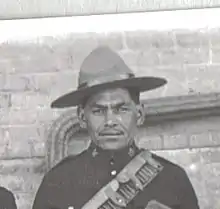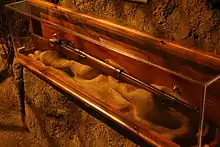Henry Norwest
Henry Louis Norwest (Northwest) MM & Bar (1881 – 18 August 1918) was a distinguished Canadian sniper in World War I.[1]
Henry Norwest (Northwest) | |
|---|---|
 Henry Norwest in 1915 | |
| Nickname(s) | Ducky |
| Born | ~1881 Fort Saskatchewan, Alberta |
| Died | 18 August 1918 (aged 37) Fouquescourt, Somme, France |
| Allegiance | Canada |
| Service/ | Canadian Army |
| Years of service | 1915-1918 |
| Rank | Lance Corporal |
| Unit | 50th Canadian Infantry Battalion |
| Battles/wars | First World War |
| Awards | Military Medal & Bar |
Early life
Norwest was born in Fort Saskatchewan, Alberta, sometime in the early 1880s, the Métis son of Louis Northwest or Watson and Geneviève Boucher, themselves both Métis. His father lived for a time with the Cree band led by Kiskaquin (Bobtail). Norwest worked as a ranch hand and rodeo performer, then for a short time he served with the Royal Northwest Mounted Police. In January 1915 he joined the Canadian army.
Military career
Henry Louis Norwest initially enlisted in Wetaskawin as Henry Louie, listing his trade as "Cow Puncher".[2] However, he was discharged just three months later for "drunkenness", according to official records.[2] He then re-enlisted in Calgary, under the name of Henry Norwest.[2]
In his nearly three years of service with the 50th Canadian Infantry Battalion, the lance corporal achieved a documented sniping record of 115 fatal shots.[2] His true number of kills could be higher, because the military only recorded hits which had been witnessed by someone else.[2] Norwest drew greatly upon his upbringing and experience as a hunter – moving with stealth, and making use of camouflage and the natural foliage around him to hide.[2] As a result of his exceptional abilities his superiors frequently sent him on reconnaissance missions into "No Man's Land" or behind enemy lines.
In 1917, Norwest earned the Military Medal during the Battle of Vimy Ridge, in recognition of his contribution to the conquering of a significant point along the ridge.[2] In the three months preceding the battle, Norwest killed 59 enemy soldiers.[2] After his death, he was posthumously awarded the bar to his Military Medal.[2] He was one of only 90 men in the Canadian Expeditionary force/Canadian Corps to earn the Military Medal with Bar.[3] Only three months before the war ended, Norwest was on a mission to find a German sniper's lair when he was killed by the enemy sniper.[2]
His Ross Rifle is currently on display at The King's Own Calgary Regiment (RCAC) Museum, part of The Military Museums in Calgary.[2] It is the second of three rifles that he used and was brought back to Canada by his spotter. The last rifle that Norwest carried was rumoured to have been taken by the German sniper who killed him on 18 August 1918 near Fouquescourt, Somme, France.

Personal life
Nicknamed Ducky, Henry Norwest was Métis of Cree/French origins from the Hobbema reserve in Alberta. Henry reportedly earned his nickname during the war because he was very popular with women at dance halls, and would dance for hours before "ducking" out on the women at the end of the night.[2] Henry was married with three children, who were all sent to a residential school in Ermineskin, Alberta, prior to his enlistment.[2] His wife died in Alberta sometime before he was killed in action.[2] His three daughters became orphans upon his death, and spent most of their childhoods in a residential school.[2] Henry is buried in the Warvillers Churchyard Extension Cemetery, Warvillers, Somme, France.
Legacy
Fort Saskatchewan's cemetery features two large stones that each bear a plaque detailing his accomplishments during the war.[2] His name was not added to the community's cenotaph until 2008.[2] The local branch of the Royal Canadian Legion hung his portrait in their canteen, named it in his honour, and placed an eagle feather, a sacred symbol in Cree culture, in glass beside his picture.[2] It is estimated that Norwest has hundreds of descendants, mostly concentrated around Samson Cree First Nation in central Alberta.
References
- "Sharpshooter: Henry Louis Norwest". Government of Canada. Retrieved 21 January 2015.
- Stewart, Briar (April 4, 2017). "Métis sniper made his mark for Canada at Vimy Ridge". CBC News. Retrieved September 7, 2020.
- https://www.scribd.com/document/32383621/Norwest-Northwest-Henry-World-War-I-Sniper